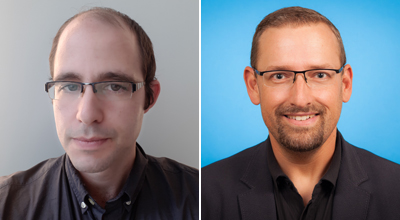Brains of university-level concussed athletes were physiologically different over one year post-injury: study

By Jennifer Stranges

Drs. Nathan W. Churchill (left) and Tom Schweizer
One year after receiving full medical clearance, the brains of young concussed athletes still continued to show signs of injury, according to one of the longest follow-up studies of brain recovery in athletes to date, led by researchers at St. Michael’s Hospital in Toronto.
According to research published in the Oct. 16, 2019, online issue of Neurology®, the medical journal of the American Academy of Neurology, the course of recovery was not complete even after the athletes’ symptoms and cognitive functions returned to normal.
Researchers conducted MRI scans of the brains of 24 athletes from University of Toronto teams in sports including football, hockey, rugby and soccer following a concussion diagnosis. They also scanned a large group of 122 matched athletic controls. All athletes in the study had been assessed for baseline cognitive function prior to their respective athletic seasons and concussed athletes were re-assessed at return to play and again one year after returning to play.
While brain activity appeared to have returned to normal at a year post-return to play, researchers continued to see white matter effects and new changes in blood flow. These findings shed new light on long-term brain changes after concussion, further challenging the idea of concussion as a temporary disturbance.
“This research is striking because the length of time of the follow-up is unprecedented,” said Dr. Nathan W. Churchill, co-author of the study and a research associate in the Neuroscience Research Program of St. Michael’s.
”Our findings show that the change in the brain continues to evolve much longer than previously thought. One year post-injury, brain function resolves, but the scans show aspects of brain structure and blood flow have changed, making this a novel finding.”
The study monitored and measured many different aspects of brain health, including structure, function, and blood flow. Researchers examined white matter, which allows for communication between different areas of the brain, and identified long-term disruptions one year after return to play. Blood flow, which is a critical component of the delivery of oxygen and glucose to the brain, was also decreased one year after return to play.
“At return to play, face-value indications of the injury – such as cognitive impairment and symptoms – appear to have cleared,” said Dr. Tom A. Schweizer, interim director of the Keenan Research Centre for Biomedical Science of St. Michael’s, director of the Neuroscience Research Program, and a co-author of the paper. “However, our findings show early and long-term brain changes in response to the concussion. This suggests a potential risk for long-term consequences, given the evidence of worse outcomes if a second concussion occurs before recovery is complete.”
Currently, athletes are medically cleared for return to play primarily based on the resolution of symptoms. However, Dr. Churchill and Dr. Schweizer said the study indicates more research is needed during this vulnerable period to better understand optimal recovery time from a biological standpoint. The researchers also said these results suggest a reconsideration of concussions as mild injuries.
This paper is an example of how St. Michael’s Hospital is making Ontario Healthier, Wealthier, Smarter.
About St. Michael’s Hospital
St. Michael’s Hospital provides compassionate care to all who enter its doors. The hospital also provides outstanding medical education to future health care professionals in more than 27 academic disciplines. Critical care and trauma, heart disease, neurosurgery, diabetes, cancer care, care of the homeless and global health are among the Hospital’s recognized areas of expertise. Through the Keenan Research Centre and the Li Ka Shing International Healthcare Education Centre, which make up the Li Ka Shing Knowledge Institute, research and education at St. Michael’s Hospital are recognized and make an impact around the world. Founded in 1892, the hospital is fully affiliated with the University of Toronto.
About Unity Health Toronto
Unity Health Toronto, comprised of Providence Healthcare, St. Joseph’s Health Centre and St. Michael’s Hospital, works to advance the health of everyone in our urban communities and beyond. Our health network serves patients, residents and clients across the full spectrum of care, spanning primary care, secondary community care, tertiary and quaternary care services to post-acute through rehabilitation, palliative care and long-term care, while investing in world-class research and education. For more information, visit www.unityhealth.to.
